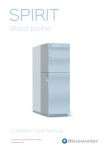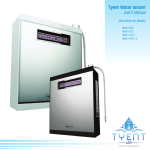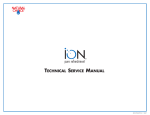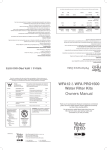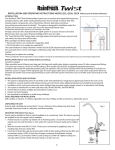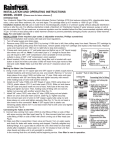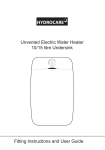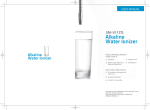Download Whirlpool KEHU309SSS User's Manual
Transcript
INSTALLATION INSTRUCTIONS 30" (76.2 CM) ELECTRIC BUILT-IN MICROWAVE/OVEN COMBINATION Table of Contents BUILT-IN MICROWAVE/ OVEN COMBINATION SAFETY..........1 INSTALLATION REQUIREMENTS ................................................2 Tools and Parts ............................................................................2 Built-In Microwave/Oven Combination Location Requirements ................................................................2 Water Filtration System Location Requirements .........................3 Water Supply Requirements ........................................................3 Electrical Requirements ...............................................................3 INSTALLATION INSTRUCTIONS ..................................................4 Prepare Built-In Microwave/Oven Combination..........................4 Remove Oven Door......................................................................4 Make Electrical Connection .........................................................5 Install Water Filtration System .....................................................6 Install Oven...................................................................................7 Complete Installation ...................................................................8 BUILT-IN MICROWAVE/OVEN COMBINATION SAFETY Your safety and the safety of others are very important. We have provided many important safety messages in this manual and on your appliance. Always read and obey all safety messages. This is the safety alert symbol. This symbol alerts you to potential hazards that can kill or hurt you and others. All safety messages will follow the safety alert symbol and either the word “DANGER” or “WARNING.” These words mean: DANGER WARNING You can be killed or seriously injured if you don't immediately follow instructions. You can be killed or seriously injured if you don't follow instructions. All safety messages will tell you what the potential hazard is, tell you how to reduce the chance of injury, and tell you what can happen if the instructions are not followed. IMPORTANT: Save for local electrical inspector's use. 8304536A INSTALLATION REQUIREMENTS Tools and Parts Gather the required tools and parts before starting installation. Read and follow the instructions provided with any tools listed here. Built-In Microwave/Oven Combination Location Requirements ■ Adjustable wrench or ⁵⁄₈" wrench Make sure you have everything needed for correct installation. IMPORTANT: Observe all governing codes and ordinances. ■ Cabinet opening dimensions that are shown must be used. Given dimensions provide minimum clearance with oven. ■ Phillips screwdriver ■ ■ Flat-blade screwdriver Recessed installation area must provide complete enclosure around the recessed portion of the oven. Measuring tape ■ ■ Grounded electrical supply is required. See “Electrical Requirements” section. ■ Hand or electric drill (for wall cabinet installations) ■ ■ 1" (25 mm) drill bit (for wall cabinet installations) ■ Level ■ Copper tubing cutter Electrical supply junction box should be located 3" (7.6 cm) maximum below the support surface when the oven is installed in a wall cabinet. A 1" (2.5 cm) minimum diameter hole should have been drilled in the right rear or left rear corner of the support surface to pass the appliance cable through to the junction box. ■ Oven support surface must be solid, level and flush with bottom of cabinet cutout. Floor must be able to support a total weight (microwave and built-in oven) of 238 lbs (108 kg). Tools needed Parts supplied (1 box, 3 plastic bags) ■ One - ³⁄₈" stem to ¹⁄₄" quick connect ■ Two - ³⁄₈" elbow to ¹⁄₄" quick connects ■ Water filter ■ #10–16 x ⁵⁄₈" screw and 1 mounting ring (to mount water filter) ■ #8–14 x 1" screws - single oven (2), double oven (4) ■ Bottom vent (supplied on some models) ■ #8–18 x ³⁄₈" screws - bottom vent (supplied on some models) Product Dimensions A Parts needed ■ UL listed or CSA approved conduit connector ■ UL listed wire connectors ■ Tubing staples/retainers ■ ¼" O.D. copper tubing (to make water connection) B E NOTE: Due to temperatures around oven, copper tubing is required. ■ Water connection device (to connect ¼" O.D. copper tubing to water source). Check local codes for type of connection required. ■ ¼" to ¼" water supply union (between copper tubing from the filter and copper tubing attached to oven) Check local codes. Check existing electrical supply. See “Electrical Requirements.” It is recommended that all electrical connections be made by a licensed, qualified electrical installer. 2 D C A. 28⁵⁄₁₆" (71.9 cm) recessed width B. 42⁵⁄₁₆" (107.5 cm) overall height C. 29³⁄₄" (75.6 cm) overall width D. 23" (58.4 cm) max. recessed depth E. 40³⁄₄" (103.5 cm) recessed height Depending on your installation configuration, more routing holes may be required. Cabinet Dimensions Typical Installation Configuration A NOTE: For unique installations contact a licensed plumber. B Cold water supply F D Hot Cold E Filter assembly location C A. 30" (76.2 cm) min. cabinet width B. 1" (2.5 cm) top of cutout to bottom of upper cabinet door C. 19¹⁄₄" (48.9 cm) bottom of cutout to floor D. 28¹⁄₂" (72.4 cm) cutout width E. 1¹⁄₂" (3.8 cm) min. bottom of cutout to top of cabinet door F. 41¹⁄₄" (104.8 cm) cutout height Water Supply Requirements A cold water supply with water pressure between 30 and 120 psi (207 and 827 kPa) is required to operate the steam feature. In Massachusetts, plumbing code 248 CMR 3.00 and 10.00 must be followed. If you have questions about your water pressure call a licensed, qualified plumber. Reverse Osmosis Water Supply Cabinet Side View IMPORTANT: The pressure of the water supply coming out of a reverse osmosis system going to the water inlet valve of the oven needs to be between 30 and 120 psi (207 and 827 kPa). If a reverse osmosis water filtration system is connected to your cold water supply, the water pressure to the reverse osmosis system needs to be a minimum of 40 psi (276 kPa). If the water pressure to the reverse osmosis system is less than 40 psi (276 kPa): ■ Check to see whether the sediment filter in the reverse osmosis system is blocked. Replace the filter if necessary. A B E D C ■ Allow the storage tank on the reverse osmosis system to refill after heavy usage. If you have questions about your water pressure, call a licensed, qualified plumber. Electrical Requirements A. 24" (61.0 cm) min. cutout depth B. 23" (58.4 cm) recessed oven depth C. Oven front D. Recessed oven E. Cabinet Water Filtration System Location Requirements For best results, do not install the water filtration system outside, or in extreme hot or cold temperatures. Temperature of water supply to the water filtration system must be between 40°F/4°C and 100°F/38°C. Do not install on hot water supply line. Locate the water filtration system near the cold water supply pipe under the kitchen sink to filter cold water. It will be necessary to drill a ½" (1.3 cm) minimum diameter hole in the upper right or left rear corner of the side wall of the cabinet under the sink to route the water supply tubing through to the oven cabinet cutout. Another ½" (1.3 cm) minimum diameter hole will need to be drilled at the rear wall in the oven cabinet cutout. If codes permit and a separate ground wire is used, it is recommended that a qualified electrical installer determine that the ground path and wire gauge are in accordance with local codes. Check with a qualified electrical installer if you are not sure the oven is properly grounded. This oven must be connected to a grounded metal, permanent wiring system. Be sure that the electrical connection and wire size are adequate and in conformance with the National Electrical Code, ANSI/ NFPA 70-latest edition or CSA Standards C22.1-94, Canadian Electrical Code, Part 1 and C22.2 No. O-M91-latest edition, and all local codes and ordinances. A copy of the above code standards can be obtained from: National Fire Protection Association One Batterymarch Park Quincy, MA 02269 CSA International 8501 East Pleasant Valley Road Cleveland, OH 44131-5575 3 Electrical Connection To properly install your oven, you must determine the type of electrical connection you will be using and follow the instructions provided for it here. ■ Oven must be connected to the proper electrical voltage and frequency as specified on the model/serial number rating plate. The model/serial number rating plate is located at the bottom of the right-hand mounting rail. See the following illustration. ■ Models rated from 7.3 to 9.6 kW at 240 volts (5.5 to 7.2 kW at 208 volts) require a separate 50-amp circuit. Models rated at 7.2 kW and below at 240 volts (5.4 kW and below at 208 volts) require a separate 30-amp circuit. ■ A circuit breaker is recommended. ■ Connect directly to the circuit breaker box (or fused disconnect) through flexible, armored or nonmetallic sheathed, copper cable (with grounding wire). See “Make Electrical Connection” section. ■ Flexible conduit from the oven should be connected directly to the junction box. ■ Do not cut the conduit. The length of conduit provided is for serviceability of the oven. ■ A UL listed or CSA approved conduit connector must be provided. ■ If the house has aluminum wiring follow the procedure below: A A. Model/serial number plate 1. Connect a section of solid copper wire to the pigtail leads. 2. Connect the aluminum wiring to the added section of copper wire using special connectors and/or tools designed and UL listed for joining copper to aluminum. Follow the electrical connector manufacturer's recommended procedure. Aluminum/copper connection must conform with local codes and industry accepted wiring practices. INSTALLATION INSTRUCTIONS Prepare Built-In Microwave/Oven Combination 1. Decide on the final location for the oven. Avoid drilling into or severing existing wiring during installation. Remove Oven Door IMPORTANT: Use both hands to remove oven door(s). 1. Open the oven door. 2. Locate the oven door latches in both corners of the oven door, and rotate the latches forward to the unlocked position. WARNING Excessive Weight Hazard A Use two or more people to move and install oven. B Failure to do so can result in back or other injury. 2. To avoid floor damage, set the oven onto cardboard prior to installation. Do not use handle or any portion of the front frame for lifting. 3. Remove the shipping materials and tape from the oven. 4. Remove the hardware package from inside the bag containing literature. 5. Remove and set aside racks and other parts from inside the oven. 6. Move oven and cardboard close to the oven’s final location. 4 A. Oven door latch in locked position B. Oven door latch in unlocked position 3. Grasp the edges of the oven door with both hands and close the oven door until it will no longer close. Lift and pull oven door toward you and remove. Set the oven door(s) aside on a covered work surface. Make Electrical Connection WARNING 4-Wire Cable from Home Power Supply IMPORTANT: Use the 4-wire cable from home power supply in the U.S. where local codes do not allow grounding through neutral, New Branch circuit installations (1996 NEC), mobile homes and recreational vehicles, new construction and in Canada. A B Electrical Shock Hazard Disconnect power before servicing. E F Use 8 gauge solid copper wire. G Electrically ground oven. Failure to follow these instructions can result in death, fire, or electrical shock. This oven is manufactured with a neutral (white) power supply wire and a cabinet-connected green (or bare) ground wire twisted together. 1. Disconnect power. 2. Feed the flexible conduit from the oven through the opening in the cabinet. 3. Remove junction box cover, if it is present. 4. Install a UL listed or CSA approved conduit connector to the junction box. A A. UL listed or CSA approved conduit connector 5. Route the flexible conduit from the oven to the junction box through a UL listed or CSA approved conduit connector. 6. Tighten screws on conduit connector. 7. See “Electrical Connection Options Chart” to complete installation for your type of electrical connection. C H D I A. Cable from home power supply B. Black wires C. Red wires D. 4-wire flexible conduit from oven E. Junction box F. White wires G. UL listed wire connectors H. Green (or bare) ground wires I. UL listed or CSA approved conduit connector 1. Connect the 2 black wires (B) together using a UL listed wire connector. 2. Connect the 2 red wires (C) together using a UL listed wire connector. 3. Untwist white wire from green (or bare) ground wire coming from the oven. 4. Connect the 2 white wires (F) together using a UL listed wire connector. 5. Connect the green (or bare) ground wire (H) from the oven cable to the green (or bare) ground wire (in the junction box) using a UL listed wire connector. 6. Install junction box cover. 3-Wire Cable from Home Power Supply Electrical Connection Options Chart If your home has: Go to section: 4-wire 4-wire Cable from Home Power Supply IMPORTANT: Use the 3-wire cable from home power supply where local codes permit a 3-wire connection. A B C H ½" (1.3 cm) 3-wire G 3-wire Cable from Home Power Supply D E F I ½" (1.3 cm) A. Cable from home power supply B. Junction box C. Black wires D. White wires E. Green (or bare) ground wire (from oven) F. 4-wire flexible conduit from oven G. Red wires H. UL listed wire connectors I. UL listed or CSA approved conduit connector 5 1. Connect the 2 black wires (C) together using a UL listed wire connector. 2. Connect the 2 white wires (D) and the green (or bare) ground wire (of the oven cable) using a UL listed wire connector. 3. Connect the 2 red wires (G) together using a UL listed wire connector. 4. Install junction box cover. Connect to Water Filter Inlet (yellow) NOTE: Use the quick connect stem and/or elbow adapter fittings in the combination needed for your installation configuration. 1. Attach the supplied ³⁄₈" to ¹⁄₄" stem or ³⁄₈" to ¹⁄₄" elbow quick connect adapter fitting to the yellow water filter inlet connection by pushing the quick connect fitting past the o-ring until you hit the backstop. Install Water Filtration System B A Install Water Filter 1. Install the water filter near the cold water supply pipe under the kitchen sink to filter the cold water. IMPORTANT: Be sure to allow a minimum clearance of 1½" (3.8 cm) under the filter system for removing the filter cartridge. Typical Installation Configuration NOTE: For unique installations contact a licensed plumber Water supply line to oven Cold water supply A. Quick connect elbow adapter fitting B. Quick connect stem adapter fitting 2. Connect the copper water supply tubing (not provided) from the home cold water supply pipe to the quick connect adapter fitting you just installed on the filter inlet (yellow) side of the water filter. 3. Pull tube to ensure it is secured. A Hot Cold C B Filter Assembly Water supply line to cold water supply 2. Attach the supplied water filter mounting ring and screw at the recommended location. 3. Attach filter to the mounting ring. A. ¼" water supply tubing B. O-ring C. Backstop If you need to release tubing: Push in collet to release tubing. With collet held in, pull tubing straight out. A Mounting ring and screw A. Collet 1½" (3.8 cm) clearance Connect to Water Filter Outlet (blue) Connect to Home Water Supply 1. Make connection to the cold water supply line. ■ A leak-tight connection to the ¼" copper tubing must be provided. ■ Check local codes for type of connection required. ■ Copper water supply tubing must be cut with a copper tubing cutter so the ends are concentric and without burrs. NOTE: It is recommended that the cold water line be soft water. 6 1. Attach the supplied ³⁄₈" to ¹⁄₄" stem or ³⁄₈" to ¹⁄₄" elbow quick connect adapter fitting to the blue water filter outlet connection by pushing the quick connect fitting past the o-ring until you hit the backstop. 2. Connect another piece of copper water supply tubing to the quick connect adapter fitting you just installed on the filter outlet (blue) side of the water filter. 3. Pull tube to ensure it is secured. Install Oven Copper water supply tubing to oven WARNING Sink Water supply connection Excessive Weight Hazard Use two or more people to move and install oven. Failure to do so can result in back or other injury. Yellow WATER IN Shutoff valve Blue WATER OUT Copper water supply tubing to cold water supply 1. Using 2 or more people, lift oven partially into cabinet cutout using the oven opening as an area to grip. NOTE: Push against seal area of oven front frame when pushing oven into cabinet. Do not push against outside edges. Filter 4. Route copper tubing through undersink cabinet and oven cabinet cutout. NOTE: Due to temperatures around oven, copper tubing is required. 2. Push against seal area of front frame to push oven into cabinet. 5. Connect the copper water supply tubing to the oven copper tubing, using a ¼" to ¼" water supply union (not provided). D A F B C E 3. Push oven completely into cabinet and center oven into cabinet cutout. 4. Securely fasten oven to cabinet using the #8-14 x 1" screws (2 for single oven, 4 for double oven) provided. Insert the screws through holes in mounting rails. Do not overtighten screws. A. To home water supply B. Rear of cabinet cutout C. Copper water supply tubing from home water supply D. ¼" to ¼" water supply union (not provided) E. Oven copper tubing F. Oven front 6. Turn on water supply. 7. Check all connections for leaks. NOTE: No flushing or conditioning of the water filter is required prior to use. A B A. Mounting rail B. Insert #8-14 x 1" screw. 7 5. On some models, the oven vent is taped to the side of the oven. With one #8-14 x ³⁄₈" screw for each side of the vent, fasten vent securely to the oven. A 6. Replace oven racks. 7. Replace oven door(s) by inserting ends of hinges into hinge slots in the oven frame. 8. Push hinges in as far as they will go and open the oven door. You should feel the oven door drop into place. 9. Rotate both hinge latches back to the locked position. 10. Check that the door is free to open and close. If it is not, repeat the removal and installation procedures. See “Remove Oven Door” section. 11. Reconnect power. 12. Display panel will light briefly, and “PF” should appear in the display. 13. If display panel does not light, please reference the “Assistance or Service” section of the Use and Care Guide or contact the dealer from whom you purchased your oven. B A. #8-14 x ³⁄₈" screw B. Oven vent Complete Installation 1. Check that all parts are now installed. If there is an extra part, go back through the steps to see which step was skipped. 2. Check that you have all of your tools. 3. Dispose of/recycle all packaging materials. 4. For oven use and cleaning, read the Use and Care Guide. Check Operation of Lower Oven 1. 2. 3. 4. 5. Turn power on. From the Main Menu touch STEAM COOK. Touch AUTO STEAM. Touch VEGETABLES. Touch START, then OK. If oven(s) does not operate, check the following: ■ Household fuse is intact and tight; or circuit breaker has not tripped. ■ Electrical supply is connected. ■ See “Troubleshooting” section in the Use and Care Guide. 6. When oven has been on for 10-15 minutes, open the oven door, look for water vapor escaping and feel for heat. If you do not see water vapor or feel heat or if an error code (“F” followed by a number plus “E” followed by a number) appears in the display, turn off the oven and contact a qualified technician. 7. Touch OFF. Check Operation of Microwave Oven 1. Fill a microwave-safe container with 1 cup (250 mL) of water and place container inside microwave oven. Close door firmly. 2. From the Main Menu touch MANUAL METHOD. 3. Touch MANUAL COOK. 4. Set microwave oven cook time to “2:00” minutes. 5. Touch START. If microwave does not operate, check the following: ■ Household fuse is intact and tight; or circuit breaker has not tripped. ■ Electrical supply is connected. ■ See “Troubleshooting” section in the Use and Care Guide. When display reads “1:00” minute, open microwave oven door. The microwave should stop cooking. Close door firmly. The interior microwave oven light should turn off. 6. Touch CONTINUE to resume preset cycle. The microwave oven should begin cooking, and the microwave oven interior light should be on. Let microwave oven complete cooking time. Tones will sound at the end of the cooking time, and the microwave oven will shut off. 7. Open microwave oven door and slowly remove container. Water in container should be hot. To set the clock and other oven functions, refer to the Use and Care Guide. If you need Assistance or Service: Please reference the “Assistance or Service” section of the Use and Care Guide or contact the dealer from whom you purchased your built-in oven. 8304536A © 2007. Whirlpool Corporation. All rights reserved. 5/07 Printed in U.S.A.










